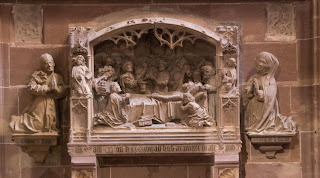Situated at the base of a mountain on the Neckar River 22
kilometers from the Rhine River, Heidelberg is a lovely old university town
with great views and some of the most expensive property in Germany. Germany’s
first public library was founded here and it was a major base for the occupying
US military until 1915 when it moved to its new headquarters in Weisbaden.
Our morning tour began with a trip up the hillside to the
castle shrouded in fog. It is a beautiful location although the heavy fog
completely obscured the views of the town and river below. The most interesting points in the castle
were the world’s largest wine keg a footprint in the brick patio created when a
knight jumped from the window above to escape an irate husband or father.
The castle itself was begun in the 14th century
and developed further over the centuries. By the 18th century it was
being used as a quarry for stones to build new homes in town. The quarrying
stopped in 1800 and restoration began including the building of a banquet hall
built in 1934.
In town we visited a church with a very modern Nativity
scene that included soccer players and Nelson Mandela.
We wandered the
Christmas markets and visited the old bridge to look at the Bridge Monkey. The official
legend about the monkey is that he is there to remind Heidelbergers that they
are equal no matter which side of the bridge they live on. Looking in the
mirror he is holding you see your own face and know that you are no better than
anyone either in front of you or behind you as you cross the bridge. An added
bonus to the legend says that if you touch his fingers you will return to
Heidelberg. Touching the mice nearby will bring children and touching the mirror
will bring wealth.
This is a new monkey created in 1979. However, the earlier
monkeys which have been on the bridge since the 15th century may
have a better story involving a dispute between two powerful men on either side
of the bridge. I don’t remember the whole story, but what our guide told us had
to do with love and sex and a monkey representing those who do bad things. The older
monkeys held the mirror in one hand with the other on its butt. The creator was
telling his nemesis that if he wanted to blame someone, he only needed to look
at himself. Thus the mirror.
By the time we left the fog had lifted for our bus ride back
to the ship and a few hours sailing to
Rudesheim. We arrived in Rudesheim at dusk and only had time to wander the
Christmas market for a few hours before dinner. It is amazing how busy every
Christmas market is. I would have thought that since just about every decent
sized town has a market, there would be some saturation point. However, every
market we visited was crowded with people. It is a great way to socialize and
spend an evening out with friends or family or both. We certainly enjoyed them.


















































